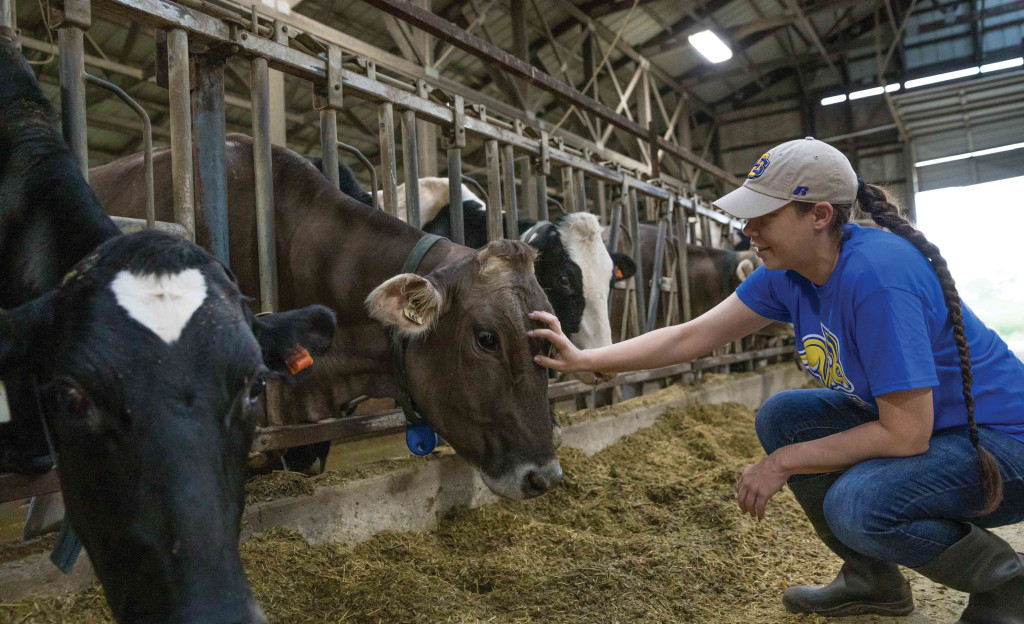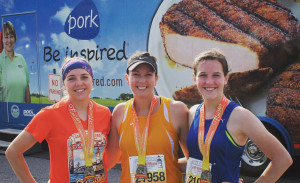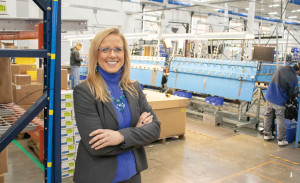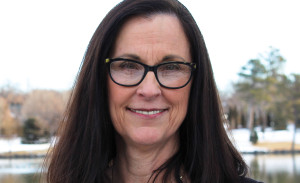Agricultural careers increasingly draw more women
What does the face of agriculture look like in the Upper Midwest?

Rhea Lawrence has been part of the growth seen in the College of Agriculture, Food and Environmental Sciences since 2008-09. Women have accounted for 79% of the college’s increase in students.
In 2012, USDA’s National Ag Statistics Bureau conducted a census of women farmers and ranchers. In South Dakota, it found 12,132 women farmers and ranchers, which is 26 percent of the total South Dakota farmers and ranchers. Nationally, it is 31 percent. Observers expect those numbers have grown in the past seven years as thousands of males retire from the occupation each year and more females have the confidence to cross into what was considered male turf.
“As women, we are hard workers; we can do the jobs on the farms just as easy as our counterparts. Now we’re taking that a step further and getting postgraduate education that is improving our industry,†said Rhea Lawrence, who grew up on a beef and horse ranch near Pine Ridge and is just completing her doctorate in dairy science production.
Animal science leading the way
At South Dakota State, 70 percent of the 2018-19 enrollment in the animal science major was female. “Some other universities with a pre-vet major have a higher percentage than us,†said Rosie Nold ’88, assistant department head in animal science. State has been at that 70 percent mark since Nold started teaching here five years ago.
“When I went to school (in the mid-’80s), I certainly wasn’t the first. I would estimate our percentage of women was 25 to 30 percent,†said Nold, who grew up on a southwest Minnesota farm. In the decades that followed, there has been “tremendous change†in undergraduate enrollment and career opportunities for females, she said.
“Women are integrally involved in all aspects of the animal science industry,†Nold said. Sometimes that is in positions that never existed 30 years ago, like an embryologist at Trans Ova Genetics in Sioux Center, Iowa. But it’s not uncommon to also find women in more traditional roles like feed sales, consulting and direct livestock management.
Comfort in numbers

Carly (Fritz) Erickson ’17 is a field representative for one of the region’s leading swine management companies. She enjoys being part of agriculture economy.
One of those is Carly (Fritz) Erickson, a 2017 animal science and speech communications graduate from Holland, Minnesota.
She now is living in Ruthton, Minn., not far from her home farm, working as a field representative for Pipestone Grow Finish, a division of Pipestone Holdings, which is a leading swine management company in the region. Every seven to 10 days she visits 20 swine facilities from 10 miles north of Pipestone to 10 miles south of Luverne in western Minnesota.
“What I find satisfying every day is knowing you’re providing food for a growing population that needs it. Not only in the community, but other people in the United States and overseas. I really enjoy knowing the fact we’re helping to feed people with a cost-effective product,†Erickson said.
Growing up on a cow-calf operation and showing horses in 4-H, Erickson always knew she wanted an ag career and enrolled at State as an animal science major.
But she admits to being “very surprised when I sat in my first animal science class and saw how many females were in the room.†That made it easier to find study partners, and she also got involved in Sigma Alpha, a professional agricultural sorority. There also is Ceres, a social sorority for ag women.
’Have … equal opportunity’
Julie Walker, an Extension beef specialist, has been the adviser of the Ceres chapter here for four years.
Through 4-H, FFA and growing up on a farm, girls develop a passion for agriculture at an early age and are often encouraged by their families to go to college to grow their ag knowledge, Walker said. Growing up in northern Minnesota, that was her case. “Me and beef cattle—I didn’t know I was interested in anything else.â€
Her career path took her to high school vo-ag before going back to college for animal science and becoming a beef specialist in 1997.
“When I started school, I was told I shouldn’t be a vo-ag teacher because I was a female. That was 1979. I told my adviser ’I’m going to do it anyway.’ Today, there is not the same stereotypes as ’that’s a male job, that’s a female job.’ The reality of it is if females are prepared and suited for the position, I think they have as equal opportunity as a male,†Walker said.
Complimentary thinking styles
Sarah Waltner is a 2001 electrical engineering graduate who is now general manager of the Applied Technology Division of Raven Industries, its ag arm.
“Ever since my high school classes, in engineering schooling and all through my career, I’ve been vastly outnumbered by men. Even now it’s very common for me to be the only woman in a room of 20. But by and large I’ve had a very positive experience,†said Waltner, who has spent 17 years at Raven and has been in Applied Technology since 2015.
“Men and women think different. I’m confident in using my strengths as a woman while appreciating the strengths my counterparts bring.
“I have a huge amount of respect for all of my male colleagues. From an engineering perspective, just like men are really good thinking about this one thing and this one thing, women think about it all at the same time. As a woman, we think about it all connected at the same time. I bring the perspective ’let’s not forgot the rest of it’ or ’let’s remember all of the reasons they’re loyal to us.’â€
When viewed as complementary thinking, there is powerful potential to solve problems, Waltner said.
There are areas of ag where the female face is still little seen. Some examples: Only 10 percent of State’s precision ag students are females. Most ag faculty members are male. For example, only five of the 20 animal science faculty are female.
Waltner would be an exception. Raven’s Applied Technology Division had $130 million in sales in FY19 and employs 250.
Leading the way
Another prominent female leader is Kim Vanneman, who, in January, became the first female South Dakota Secretary of Agriculture. She is one of seven females nationwide to hold their state’s top ag position. Vanneman, a 1979 State animal science graduate, was appointed by the state’s first female governor, Kristi Noem, also a State grad.
Vanneman was raised on a farm and ranch north of Chamberlain and always had her sights set on a career in agriculture.
“I loved working on the ranch with my dad. I just knew I wanted to go to South Dakota State and major in ag business,†said Vanneman. After graduation, she married Clint and they moved back to the Vanneman family farm near Ideal. In addition to her active role on the farm, she was a state legislator and a member of several Farm Credit boards.
“There weren’t a lot of women on (the Farm Credit) boards when I started serving. By the time I left that position, there were more female board members. Also, there were several female CEOs in the Farm Credit system,†said Vanneman.
“It’s truly an honor to be the South Dakota Secretary of Agriculture,†she said. “I’m very blessed to represent the industry that I love. If I can encourage women through this role, that’s an added bonus.â€
Touting ag’s benefits
Of course, being a voice for agriculture isn’t a one-man, or woman, job.
Walker, the Ceres adviser, said, “One of the things that women have brought to the table, due to degrees like ag leadership and ag communications, is we’re making a better attempt at educating the public that is not associated with agriculture. …
I think people are starting to see the importance of agriculture.â€
That is great news for Maddie (Schafer) Hokanson, a May graduate in agriculture communication, education and leadership.

The Schaffer family represented Minnesota Pork when they ran the famed Gary Bjorklund Half Marathon in Duluth, Minnesota, in 2016. Monica Schaffer, middle, with her daughters, Kendrah, left, and Madison (now Hokanson).
In 2017, she was one of three people selected as the National Pork Board’s inaugural Pig Farmer of Tomorrow. She traveled to Illinois and Missouri to speak to high school and college students interested in careers in the pork industry, attended the National Pork Industry Forum in Georgia and posted on social media to inspire and connect with the next generation of pig farmers. It is funded by checkoff dollars.
“The experience opened up opportunities with the National Pork Board now,†said Hokanson, who is doing freelance promotion.
“I’m helping with farm tours and filming. The National Pork Board will take bloggers, dietitians, nutritionists, etc. to pig farms. That requires coordinating transportation, hotels, having the right-sized clothing for people when they shower in and out. It’s taking pictures, posting on social media and answering questions people have on tours,†she said.
That is in addition to doing contract freelance work in sales and marketing support for Legend Seed and taking over the books at Schafer Farms.
It’s fulfilling a goal she has had since 2011. “In ninth grade, I started volunteering with the Minnesota Pork Board’s Oink Outing events. We would go to farmers markets and Minnesota Pork would donate a pound of ground pork to Second Harvest Heartland for every question asked. I found I enjoyed talking to people who don’t really know where their food comes from,†Hokanson said.
’Helping to feed the world’
Assistant Department Head Nold said, “We have a much more diverse group of people working in agriculture, both from gender and otherwise. That’s good. Different people bring different things to the table.â€
And that’s a literal table.
Secretary Vanneman said, “Food also brings our busy families together for our dinners. It’s important to build bridges between consumers and producers.â€
The role of provider is what brings satisfaction to many involved in farming.
Lawrence, the dairy science graduate student, said, “I feel we’re helping to feed the world either through milk or meat products. Agriculture is the first step in getting those products to the table to feed an ever-increasing world population.â€
– Dave Graves








